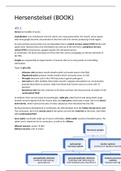Summary
Summary CH49 Brain System
- Course
- Institution
- Book
Summary of the topic brain system from Campbell Biology a Global Approach, 11th edition. This summary includes notes of accompanying MasteringBiology assignments, lectures and any lectures. Summary of the topic of brain from Campbell Biology a Global Approach, 11th edition. This summary includes n...
[Show more]




